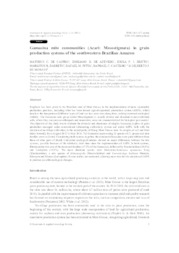Gamasina mite communities (Acari: Mesostigmata) in grain production systems of the southwestern Brazilian Amazon.
Gamasina mite communities (Acari: Mesostigmata) in grain production systems of the southwestern Brazilian Amazon.
Author(s): CASTRO, M. C. de; AZEVEDO, E. B. de; BRITTO, E. P. J.; BARRETO, M. R.; PITTA, R. M.; CASTILHO, R. C.; MORAES, G. J. de
Summary: Emphasis has been given in the Brazilian state of Mato Grosso to the implementation of more sustainable production practices, including what has been termed agrosilvopastoral production system (ASPS), which involves the integration of different types of land use in a same area along time, seeking increased ecological stability. The Gamasina mite group (order Mesostigmata) is usually diverse and abundant in non-cultivated soils, where they can prey on arthropods and nematodes; some are commercialized for biological pest control. The objective of this study was to evaluate the diversity and abundance of edaphic Gamasina in plots of grain production managed under conventional (alternating cultivation) system and under ASPS, both with the adoption of no-tillage cultivation, in the municipality of Sinop, Mato Grosso state. In samples of soil and litter taken biweekly from August 2015 to May 2016, 762 Gamasina representing 32 species of 21 genera and nine families were collected. Considering both systems together, the dominant Gamasina were quite different from those of other parts of Brazil. Calculated ecological indexes showed no major differences between the two systems, possibly because of the relatively short time since the implementation of ASPS. In both systems, Rhodacaridae was one of the dominant families (37.5% of the Gamasina), followed by Macrochelidae (20.9%) and Laelapidae (18.8%). The most abundant species were Multidentirhodacarus squamosus Karg (Rhodacaridae), a new species of Holostaspella (Macrochelidae) and Cosmolaelaps barbatus Moreira, Klompen and Moraes (Laelapidae). Future studies are warranted, allowing more time for the adoption of ASPS to produce possible ecological changes.
Publication year: 2021
Types of publication: Journal article
Keywords: Acari, Amazona brasiliensis, Corn, Grão, Mesostigmata, Milho, No-tillage, Sinop-MT, Soja, Soybeans, Ácaro
Observation
Some of Embrapa's publications are published as ePub files. To read them, use or download one of the following free software options to your computer or mobile device. Android: Google Play Books; IOS: iBooks; Windows and Linux: Calibre.
Access other publications
Access the Agricultural Research Database (BDPA) to consult Embrapa's full library collection and records.
Visit Embrapa Bookstore to purchase books and other publications sold by Embrapa.

